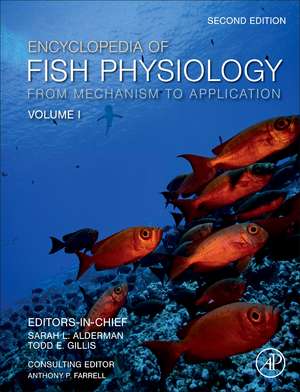Encyclopedia of Fish Physiology
Sarah L. Alderman, Todd E. Gillisen Limba Engleză Hardback – 19 mar 2024
Much has changed in the field of fish physiology since publication of the previous, Prose award winning, edition. For example, we understand better the impacts of global climate change on the physiological systems of fish, and we have gained a deeper mechanistic understanding of physiological processes through technological advancements such as gene editing with CRISPR, whole genome sequencing, and quantitative ‘omic` approaches. The new edition greatly expands the closing thematic section focused on applying fish physiology to real world challenges with topics including ocean acidification, declining habitat quality due to human activities, and the use of zebrafish in biomedical studies on tissue regeneration, neurological disorders and cancer.
- Comprehensive single resource on fish physiology that covers a diverse range of topics to educate and fascinate
- Written by leading experts in the field, offering topical overviews with a suggested reading list for those wanting to learn more
- Structured, accessible chapters include graphical and bulleted summaries that can be used as teaching material
- Follows a set template, making the work consistent and easy to navigate
Preț: 9234.05 lei
Preț vechi: 12181.09 lei
-24% Nou
Puncte Express: 13851
Preț estimativ în valută:
1766.92€ • 1925.33$ • 1488.90£
1766.92€ • 1925.33$ • 1488.90£
Carte tipărită la comandă
Livrare economică 16-30 aprilie
Preluare comenzi: 021 569.72.76
Specificații
ISBN-13: 9780323908016
ISBN-10: 0323908012
Pagini: 2400
Ilustrații: Approx. 1300 illustrations (1300 in full color)
Dimensiuni: 216 x 276 mm
Greutate: 0.45 kg
Ediția:2
Editura: ELSEVIER SCIENCE
ISBN-10: 0323908012
Pagini: 2400
Ilustrații: Approx. 1300 illustrations (1300 in full color)
Dimensiuni: 216 x 276 mm
Greutate: 0.45 kg
Ediția:2
Editura: ELSEVIER SCIENCE
Cuprins
The Encyclopedia is structured in 3 volumes with 4 major sections that group topics and chapters thematically. This mirrors the structure of the first edition, but some topics have been reorganized and some new topics introduced. * indicates a change from the original edition.
Volume 1: The Senses, Integrating Systems*, Behaviour, and Reproduction – this volume is about how fish interface with the world - Sensing the Environment e.g. the brain and nervous system, vision, hearing and the lateral line, electroreception, olfaction - Endocrine and Immune* Systems e.g. introduction to major hormone systems and their role in regulating physiological processes - Behavioural Physiology e.g. predator/prey, reproductive behaviours*, dominance, schooling*, sleep, communication* - Reproduction e.g. reproductive strategies*, sex differentiation, early development*
Volume 2: Gas and Ion Exchange, Circulatory System, Energetics*, and Movement* – this volume is about how fish function internally - Gas Exchange and Ion homeostasis e.g. respiration, osmoregulation, acid/base balance, structure and function of the gills and kidneys - The Heart, Vasculature, and Blood e.g. comparative morphology, regulation of heart function, retes, blood cells, Root effect - Energy Homeostasis e.g. food intake, digestive system, metabolism, excretion - Muscles and Movement e.g. musculoskeletal system, biomechanics of swimming, locomotion, migration
Volume 3: Adaptations, Specializations, and Applications – this volume establishes the importance of fish physiology by placing it in the context of other disciplines - Responses and Adaptations to the Environment e.g. hypoxia, thermal acclimation, seawater transition, bioluminescence - Life in Extreme Environments* e.g. complete darkness (cavefish), subzero temperature (icefish), alkaline lakes (cichlids), intertidal fish - Physiological Specializations of Different Fish Groups e.g. deep sea fish, air-breathing fish, elasmobranchs - Applications of Fish Physiology e.g. biomedical applications (neuroscience*, regeneration*, disease models), food science* (aquaculture; petri dish sushi), toxicology, climate change*, conservation physiology*
Volume 1: The Senses, Integrating Systems*, Behaviour, and Reproduction – this volume is about how fish interface with the world - Sensing the Environment e.g. the brain and nervous system, vision, hearing and the lateral line, electroreception, olfaction - Endocrine and Immune* Systems e.g. introduction to major hormone systems and their role in regulating physiological processes - Behavioural Physiology e.g. predator/prey, reproductive behaviours*, dominance, schooling*, sleep, communication* - Reproduction e.g. reproductive strategies*, sex differentiation, early development*
Volume 2: Gas and Ion Exchange, Circulatory System, Energetics*, and Movement* – this volume is about how fish function internally - Gas Exchange and Ion homeostasis e.g. respiration, osmoregulation, acid/base balance, structure and function of the gills and kidneys - The Heart, Vasculature, and Blood e.g. comparative morphology, regulation of heart function, retes, blood cells, Root effect - Energy Homeostasis e.g. food intake, digestive system, metabolism, excretion - Muscles and Movement e.g. musculoskeletal system, biomechanics of swimming, locomotion, migration
Volume 3: Adaptations, Specializations, and Applications – this volume establishes the importance of fish physiology by placing it in the context of other disciplines - Responses and Adaptations to the Environment e.g. hypoxia, thermal acclimation, seawater transition, bioluminescence - Life in Extreme Environments* e.g. complete darkness (cavefish), subzero temperature (icefish), alkaline lakes (cichlids), intertidal fish - Physiological Specializations of Different Fish Groups e.g. deep sea fish, air-breathing fish, elasmobranchs - Applications of Fish Physiology e.g. biomedical applications (neuroscience*, regeneration*, disease models), food science* (aquaculture; petri dish sushi), toxicology, climate change*, conservation physiology*
